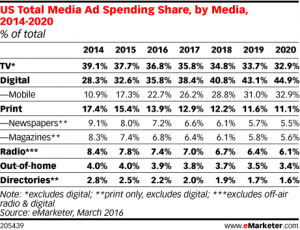
Traditional Media is Dying – Where Should I Spend My Marketing Budget?
Posted in:
The State of Traditional Media
Have you ever found yourself stuck in traffic on a major highway, hoping that the gridlock would break soon? The stretch of I-95 leading into the heart of Center City Philadelphia is a perfect example of one of those highways that always seems to accumulate traffic. It is also the perfect depiction of advertising saturation, as both sides of the highway are plastered with extended rows of billboards. It’s overwhelming to see the plethora of billboards sitting on top of one another – furthermore, it is difficult to understand why a marketing executive would spend money on such an outdated advertising medium that is barely ever remembered by commuters.
How much value can a company be getting from plastering their name, logo, and promotion on a billboard? For that matter, how and why are marketing professionals continuing to spend money on advertising channels that don’t offer a substantial amount of value and return?
It’s no secret that the value of traditional media is declining significantly, as other forms of multimedia gain popularity and become more valuable and simple to utilize. TV spots and commercial advertising are becoming less and less relevant with the rise of streaming sites and the decline of cable subscriptions. Additionally, radio is now outdated with other sources of music streaming becoming abundant, and billboards do not offer the same value as they once did because of over-saturation and the negative experiences they are associated with (i.e. terrible work commutes, gridlock traffic, subpar recall rates, need we say more?)
 In fact, 2017 marks the first year when total spending on digital advertising surpasses that of TV, Print, and Radio spending. Staying on top of the ever changing behaviors and preferences of consumers has become essential – adjusting your marketing channels and tactics must be based on knowledge of those consumer preferences.
In fact, 2017 marks the first year when total spending on digital advertising surpasses that of TV, Print, and Radio spending. Staying on top of the ever changing behaviors and preferences of consumers has become essential – adjusting your marketing channels and tactics must be based on knowledge of those consumer preferences.
With these trends in mind – it is clear that marketing executives, regardless of their industry, will have some decisions to make when allocating marketing budgets. The question is – where should they allocate those dollars?
The following three avenues are available options to spend your available marketing budget.
1. Digital Marketing
The growth of digital marketing is skyrocketing and the amount of money spent on digital avenues, including email marketing, social media, and online digital marketing (web banners), is on the rise.
There are many advantages to investments in these marketing tactics:
- Cheap – You can spend as much or as little on digital marketing as you’d like. These channels make it more efficient to push more content, advertisements, and sweepstakes with less money. Many marketers view investing in digital channels as a way of optimizing their spending, especially at times when budgets might be getting slashed or tightened.
- Trackable – By pushing content through ads, you have the ability to measure impressions, clicks, and conversions which are otherwise very difficult to track in traditional marketing.
- Targeted – Digital advertising offers a variety of ways to target consumers by demographic, interests, and more. This isn’t perfect, but it provides better targeting than the “shotgun” approach of a billboard.

The rise of mobile digital advertising is providing fuel for increased spending in the digital advertising movement. However, marketing leaders should proceed with caution when spending on digital.
While digital ads are scalable and easy to implement, they are often viewed as intrusive and do not produce the best conversion rates for customers. Consumers have become more impatient and less likely to click on any pushy advertisements while on their computers or phones. Digital ads are an effective way to get your brand out there to promote certain offerings, but it is simply unwise to allocate all of your newly available marketing dollars strictly to digital.
2. Events and Tradeshows
The opportunity to bring your brand to an event and set up a display booth or promotional giveaway area can be very impactful.
There are many benefits to investing in events and tradeshows:
- Unique brand experience – Tradeshows and events provide the opportunity to bring your brand to life. It’s a point of activation that people get to uniquely experience your brand in-person. Just make sure it’s the right event for your audience!
- 1-to-1 with customer – Events provide a unique opportunity to actually talk to your customers. You get to build a relationship with them and learn more about their wants, needs, and gaps that your product offering doesn’t yet fulfill.
- Competitive landscape – Especially at tradeshows, you get an opportunity to see companies in your industry up close. You can see see who else is competing in your space and the strategies that they’re implementing.
In-person events are a powerful medium to make your elevator pitch and to find the right people to be pitching your business to. If you’re ready and willing to prepare and come up with strategy to attend these events, they can directly translate to achieving marketing goals.

Under Armour utilizes tradeshows to introduce new product lines and build brand affinity
However, these events don’t guarantee immediate success – it is important to pick and choose the right tradeshows to attend for your brand. Additionally, they are generally quite expensive and require a lot of time and preparation to execute effectively. You want to be sure that you’re sending the right representatives to market your company and brand – the better prepared you are, the more successful and worthwhile the investment will be.
3. Local, Community Marketing
This is a marketing channel that is generally straightforward to execute and yet so heavily underutilized. One example of local marketing include building a partnership with local businesses, such as grocery stores or retailers. Other avenues of local marketing include contributing to a charity event such as the local in-town half marathon or community fair or sponsoring the local youth sports league.
 Building Your Brand on the Local Level!
Building Your Brand on the Local Level!
Here are the advantages to local and community marketing:
- Hyperlocal targeting – As discussed in a previous article, local marketing allows companies to focus in on a specific region, community, or even zip code and can be very powerful for bolstering a brand’s or company’s marketing mix. Because local marketing is so heavily targeted, you’re able to reach specific people in the community for significantly less money than many other marketing channels.
- Support the Community – Through the relationships you build in supporting the community, you’re generating positive brand perception and association. This is incredibly important given that 83 percent of respondents to a Forbes survey believe that companies should be supporting nonprofits and charities and 88 percent believe that businesses and brands should be achieving their business goals while improving society.
- Unique channel – You won’t find a better way to reach a passionate and engaged audience than through a local marketing initiative. Community marketing will help to distinguish your business from your competitors and doesn’t require a large portion of your budget in order to be successful.
However, this marketing channel is fragmented and difficult to bring to life. Numerous local organizations are volunteer-run and driven, which makes managing those relationships time consuming and at times overwhelming. Additionally, local marketing does not allow you to reach the largest quantity of people in the most efficient way possible. You want to be sure to find the best organizations to build relationships with when considering local marketing as a marketing channel.
It’s All About Balance
At the end of the day, it’s important that your marketing mix has a steady balance of channels that reach and meet the needs of all consumer preferences.
We hope that the examples above provide insight into current trends and ways to spend your marketing budget. With digital spending on the rise and traditional media declining each year with no signs of slowing down, it’s ultimately up to you to re-allocate those marketing dollars and keep your brand messaging consistent throughout.
